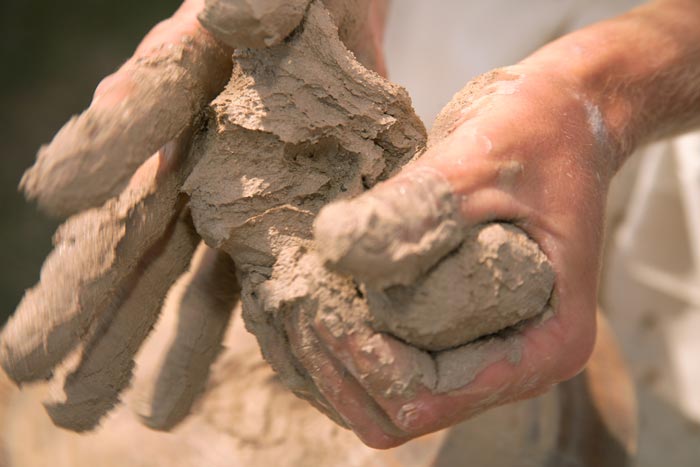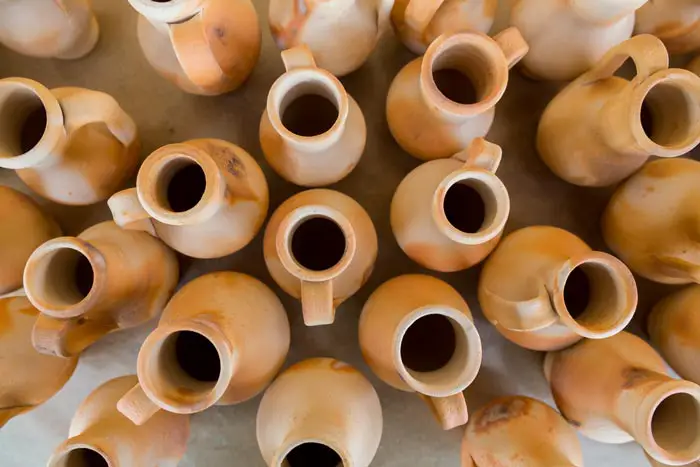Clay is not just clay. Anyone who ever worked with clay will confirm that. Today we look at two types of clay and ask: what is the difference between earthenware clay and stoneware clay? To answer this we will have an in depth exiting look at differences and similarities between the two types of clay and their uses in pottery. Let’s start off by defining exactly what earthenware is and what stoneware clay is.
Table of Contents
What is Earthenware?
Earthenware is a kind of pottery that has not been fired below the temperature of 1,200 degrees Celsius thus will absorb liquids such as water up to 5 to 8 percent. The term Earthenware‘ can also be used to classify any type of clay which has a 10 to 15 percent absorption rate after it undertakes the process of firing. Earthenware comprises all primordial and primitive pottery whatever the color, most building bricks, almost all European pieces up to the seventeenth century, most of the pieces from Egypt, some from China, and some of the finer wares that form the greater part of our tableware today. Pit fire were commonly the method of creating earthenware potteries dating back from early 29,000-25,000 BCE. Earthenware clay bodies are customarily made of secondary clay.

Basic earthenware is often called terracotta and can be made susceptible to water by coating it with ceramic glaze that is usually fused into the pottery through firing. After it undergoes the process, Earthenware turns opaque in color like white, buff or red which is usually because of the iron in the clay. Glazing earthenware pottery is highly important for it to be usable since after firing this clay turns obscure and soft making it capable of being scratched and damaged by a knife or a pointy object. The color produced may vary and depend on the intensity of the heat used, like in order to produce a reddish terracotta color you lower the temperature and brown or even black can be made through a higher temperature.
The Combined Nomenclature of the European Communities says that the clay used is usually combined with other diverse amounts of minerals such as feldspars. The general formulation for common contemporary earthenware is 25 percent kaolin, 25 percent ball clay, 35 percent quartz and 15 percent feldspar. Earthenware bodies commonly display higher capability of plastic deformation or the ability of a material to experience irreversible deformation. There are several types of Earthenware including terracota, redware, victorian majolica, lusterware, raku, ironstone china, and yellowware.
What is Stoneware?
Stoneware is a term used either for dense pottery or ceramic that is fired at a high temperature to produce a durable, impermeable to liquid and a non-porous clay that makes it possible to last a lifetime. Stoneware takes its name from its stone-like qualities. Common household items are usually made up of this type of clay like beer steins, crocks, coffee mugs, casserole and a lot more. Stoneware emerged after Earthenware. It usually requires a high firing temperature ranging from 2,000 degrees to 2,400 degrees Fahrenheit which is hotter than a lava volcano. The high temperature used is essential in glazing the outside of the piece to glass making sure it is vitrified. Stoneware was first created in the Indus Valley and in China around 2000 years ago. It did not reach Europe until the 1500s in Germany.
Potters can make these stoneware with numerous and various colors today. Stoneware pottery is strong and hard. It is also elegant and versatile which is capable of being turned into anything; ranging from a personalized trophy to a baking dish or pan. It is also great in retaining heat and spreading it evenly than other types of pottery and can possibly stand up to the heat from a microwave, dishwasher or if properly made and under the right conditions, in an oven.

Stoneware often has particles that can produce gases upon decomposition that may cause bloating if the body undergoes fire to a near zero porosity. It also contains refractory particles that do not melt during the process. The particles form a fired skeletal composition with voids in between each particle and in these the feldspars would melt to create a bond and densify the structure hence making it more durable and sturdy. Stoneware bodies however, does not have as much strength compared to a porcelain because it does not have as much glass development taking place and not as much mineral transformation occurs.
There are three ways in creating stoneware. First is through slip casting which involves pouring liquid clay into a mold and letting it form a cast inside which allows you to create more complicated and complex designs. However it is also very fragile and is not able to withstand high temperatures. Next is molding in which you insert clay into a mold before you fire it. This is a very common method to mass produce for it is cheap and easy to do. Lastly is wheel throwing which is very commonly used by potters. The main tool used is the potter’s hands which results in better quality.
Similarities Between Earthenware and Stoneware
Both Stoneware and Earthenware are made through the process of firing the clay to produce pottery. If both baked with extreme heat, a process that is commonly known as firing, it becomes permanently solid. Both pottery when fired undergoes physical and chemical change in which would first lose water and then chemically bound water.
Silica would melt because of the heat and produce new minerals and crystals that would make the product stone-like after the process. Both Stoneware and Earthenware are non reactive to chemicals. White Earthenware and Stoneware also has the same typical composition which is Feldspar, Ball Clay, Kaolin and Silica.
Both are also heavier and less refined compared to the conventional standard porcelain china. When you handle and touch the pieces, both feel closer to its former starting ingredient and have a more rustic look to it.
To sum up the simillarities we have:
- Both are made by baking the clay to produce pottery
- Both are non reactive to chemicals
- Heavier and less refined than conventional porcelain china
Differences between Earthenware and Stoneware
Stoneware and Earthenware have a few similarities but have numerous differences. Let’s have a brief look at each difference before we explore them in detail.
- Ability to retain liquids
- Porosity
- price
First of which is its ability to retain liquids such as water. They differ from Earthenware and are slightly porous which could result in water soaking into the pottery if not properly glazed or sealed even when it is fired to maturity. So it is commonly used as decorative pieces or only used during special occasions since these pieces are usually hand painted and are very fragile and can easily be chipped and break when not carefully handled.
This piece can also be used as a planter because its porosity can aid the plant’s irrigation system thus help in keeping the plants healthy and the soil from souring.
Keeping in mind it’s porosity it is not highly recommended to use as kitchenware since it could absorb the liquid or stain the other kitchenware you have. Earthenware pieces generally shrink less compared to stoneware so it is often used for sculptures. It is also resistant to thermal shock and will likely crack similar to glass. Advantages in using Earthenware for sculptures and decorative pieces is its range and ability to provide a brighter palette hence more pleasing to the eyes. Since it also does not require a lot of heat less energy is needed to produce it.
The clays can often be used right out the ground after cleaning it. However, Stoneware is non porous when fully fired to its maturity specifically recommended for the type of clay being used. This kind of pottery is commonly used a lot like as a dishware that is handed out around the table since this piece can hold water well and is also food safe. Its less porous surface aids in minimizing the spread of bacteria. This type can be used inside the oven for baking as well.
Comparing firing temperatures and price of each type of clay
The temperature used for firing is also different in which Earthenware has to be at 1,915 degrees Fahrenheit which is much lower compared to Stoneware that is fired at 2,185 degrees Fahrenheit. The difference of the temperature used also affects the resistance and durability of the piece created. Earthenware is not as strong as Stoneware but can be strengthened through glazing that hardens the surface and makes it non porous and aids in helping the pottery water resistant. In terms of its cost, Earthenware is certainly the least expensive type of pottery but it’s the least durable type as well because of its lower quality of clay used.
Stoneware is a little bit more expensive compared to Earthenware because of the quality of the clay hence is it more durable. In terms of a simpler way to look and identify the pottery when looking at a finished piece, distinguishing through the texture is the easiest. Earthenware will commonly feel chalky and the base may look shiny and glazed. Stoneware,however, will feel gritty and have a sandy texture. Like how different clays require different temperatures, glazes that are to be used in making these pieces are the same.
Glazes for stoneware must melt and incorporate with the same temperature used that’s formulated for the stoneware and same goes for the earthenware. Always note that the glaze that’s formulated for the stoneware will not work for the earthenware pieces and vice versa and if it will be done it may risk ruining the piece and kiln shelf used as well. The glaze in Stoneware pieces, unlike the Earthenware which is on the surface of the clay, actually melts somewhat into the surface at the interface.

